Kirkwall, Orkney Islands, Scotland, UK 作者: 来源: 发布时间:2021-09-17
I. Population and Area
Continent: Europe
Country: The U.K
State/Province: Scotland
City/Town: Kirkwall, Orkney Islands
Total Area: 1.40 (sq mi)
Population in 2015: 9.24 (thousand)
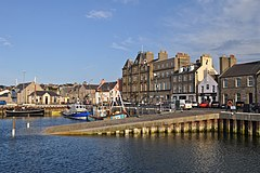
II. Natural Geography (environment and resources)
Geography
Kirkwall is 130 miles (210 kilometres) north of Aberdeen and 528 mi (850 km) north of London. It is situated on the northern coast of Mainland Orkney with its harbours in the bay of Kirkwall to the north, and with Scapa Flow 1.4 mi (2.3 km) to the south. Its parish, St Ola forms the isthmus between Firth and Holm. It is the most populous island settlement in Scotland.
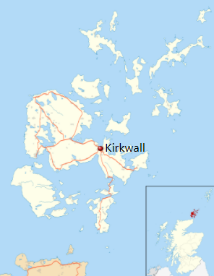
Climate
Kirkwall experiences an oceanic climate, with strong maritime influence of temperatures. This means it is generally cooler than the rest of the UK, this is especially notable in summer. Even so, its relative proximity to mainland Scotland renders it warmer than Shetland, although temperatures above 20 °C (68 °F) are rather infrequent. Winters are damp, chilly and windy, but are very mild for their latitude due to the Gulf Stream passing to its west, enabling sea surface temperatures to remain stable. This results in winter temperatures very typical for the generic British climates, in spite of its high latitude with infrequent snowfall. Even so, the said latitude of Kirkwall means a strong difference in terms of daylight between the solstices. In summer, the weak sun strength is not capable of warming Kirkwall up much, unlike similar latitudes over larger landmasses to its east in relative proximity such as the Baltic Sea region where even coastal locations average up to 7 °C (13 °F) warmer than Kirkwall during July days. Due to a lack of warm air enabling convection, thunderstorms and heavy rainfall in summer are rare occurrences, resulting in a drying trend during that season.
Transport
Kirkwall is a port with ferry services to Aberdeen and Lerwick, as well as the principal north islands in the group. Hatson pier, the main ferry terminal, is some 2 mi (3 km) outside the town centre. The Aberdeen, Leith, Clyde & Tay Shipping Company operated steamer services to Kirkwall from 1836, with successor companies operating until 2002. Kirkwall Airport, the main airport for Orkney, is 2 1⁄2 mi (4 km) southeast of the town. There are no passenger rail services in Kirkwall, the nearby railways having been industrial or military.
III. Economy
There are fairly wide variations in the extent of increase in the various areas over the years with Orkney’s GDHI displaying increases well above the regional and national averages.
Source: Office for National Statistics. It is not possible to establish the reasons for this but Orkney and the wider Inverness/Moray area, both having strong agricultural economies, demonstrate the greatest increases over the period 2005-2013. Additionally Orkney has a small number of residents working off-shore in higher paid jobs which may impact figures. During the same period, the construction sector in Orkney was, overall, also healthy, partly as a result of significant public sector investment. Nevertheless, the possible explanations are purely speculative and the income statistics also come with the usual health warning with regard to risk of error due to small sample sizes.
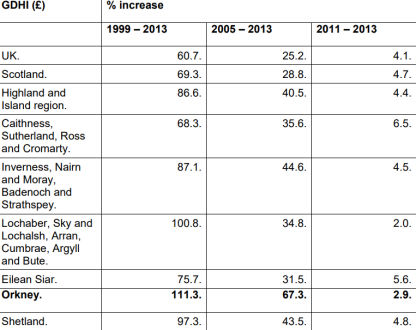
Note: These unemployment rates represent the proportion (%) of the resident population who are of working age and who are seeking employment (ages 16 – 64).
Up to September 2015 the headline Claimant Count figures include people claiming Jobseeker’s Allowance (JSA). As of October 2015 this figure includes people claiming JSA and Universal Credit.
The above table illustrates the unemployment rate measured by Claimant Count rate (%).
Orkney’s average unemployment rate rose back in 2011 and continued to fall until 2015, with an average level in 0.6%. This compares to average Scottish and UK unemployment rates from December 2015 of 2.1% and 1.8% respectively.

Reference Website:
https://www.orkney.gov.uk/Files/Business-and-Trade/Economic_Review/Economic_Review_2016.pdf
IV. Industrial Characterisitics
Major industries:
Kirkwall, royal burgh (town), seaport, and chief town of the Orkney Islands, Scotland, off the northern tip of the Scottish mainland. It was designated a royal burgh in 1486. Early Norse influence persisted as late as the building of the 12th-century red sandstone St. Magnus Cathedral, a dominant feature of the present town. The ruins of the Earl’s Palace and 17th-century houses standing gable-end to the narrow paved streets are quite picturesque. Kirkwall’s manufacturing activities include boatbuilding and the processing of local agricultural produce—whisky distilling, egg packing, creameries, beef, and cheese making. The exploitation of North Sea oil and the building of a landfall terminal at Flotta in Scapa Flow, 12 miles (19 km) to the southwest, has led to some development of offshore servicing and supply for the oil industry at Kirkwall. The town functions mainly as a commercial and service centre for the Orkney Islands and is also the islands’ historic county town (seat) and administrative centre. Pop. (2001) 6,700; (2011) 7,190.
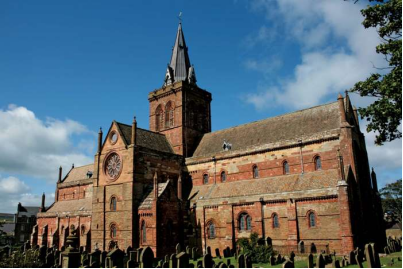
Major projects and related introductions:
A design to stimulate the local area
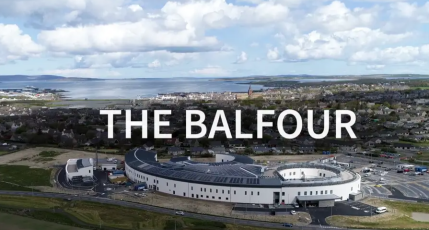
NHS Orkney issued a very specific, bespoke brief that required a rural general hospital with particular attention to be paid to the unique needs of Orcadians. Working with Keppie, the hospital was designed to put people first and make a positive contribution to the environment, local community and economy. It is predicated on 'place-making' to give the whole building a depth and level of design missing in many hospitals. This rural general hospital has a large number of small departments and areas, several of which need distinct identities. An interrelated series of ‘streets’ and spaces are situated along patterns of established movement, arranged around a single central hub. From this public space, wayfinding is easy and intuitive, and the space is visually connected with external courtyards to further remove the traditional institutional associations. The different spaces and activities come together effectively, delivering efficient clinical adjacencies that were required. The design is a strong, contemporary building that is rooted in the culture and context of Orkney in general, but Kirkwall in particular. Robertson Specialist Division carried out all external render, providing a brilliant white water- and dirt-resistant finish that is suited to the location Construction of atrium hub of The Balfour, NHS Orkney hospital and healthcare facility
Reference Website:
https://www.robertson.co.uk/project/balfour-orkney
https://www.orkney.com/life/live/economy
V. Attractions
1. Orkney Museum:
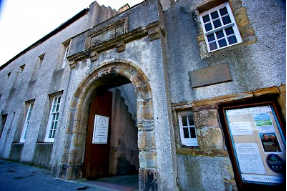
Telling the story of Orkney, all the way from the Stone Age to the present day, the Orkney Museum contains an internationally important collection of artefacts and historical items. A packed programme of temporary exhibitions, covering a wide range of Orkney related subjects, along with activities for all the family, make the museum an essential stop on a tour of Kirkwall.
2.St magnus Catherdral:
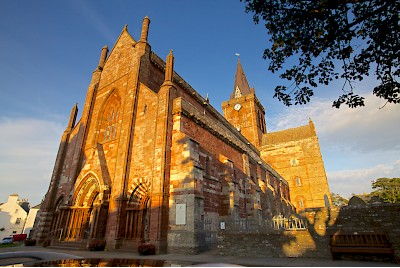
Founded in 1137 and dedicated to the martyred Magnus Erlendsson, Earl of Orkney, St Magnus Cathedral is one of the islands’ most significant landmarks, dominating the skyline of the City and Royal Burgh of Kirkwall.
Built over a 300-year period, using distinctive red and yellow Orcadian sandstone, St Magnus is the most northerly cathedral in the UK and is unique in that it is owned by the people of Orkney, rather than the church. Guided tours of both the lower and upper levels of the Cathedral are available, with the spire offering breathtaking views across Kirkwall.
3. Hatston Pier Cruise Ship Berth:
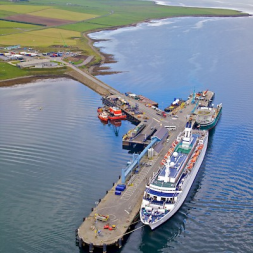
Hatston is Scotland’s longest deep-water commercial berth at 385 metres and 10.5 metres draft. The berth also plays an important part in Orkney’s marine energy industry, serving as a base for tidal power developers and support companies. A complimentary shuttle bus operates from here to the Kirkwall Travel Centre, with the journey into town taking approximately seven minutes.
Reference Website:
https://www.cruise-orkney.com/things/kirkwall
VI. History
The town is first mentioned in Orkneyinga saga in the year 1046 when it is recorded as the residence of Rögnvald Brusason the Earl of Orkney, who was killed by his uncle Thorfinn the Mighty. In 1486, King James III of Scotland elevated Kirkwall to the status of a royal burgh. On the west edge of the town, surrounded by Hatston Industrial Estate, is a prehistoric ancient monument, Grain Earth House (Historic Scotland), a short low stone-walled passage deep underground leading to a small pillared chamber. This is the form of earth house or souterrain characteristic of the Northern Isles (although Grain is unusually deep below ground). It was originally connected to a surface dwelling, which has since disappeared, and the original purpose of these Iron Age structures remains unknown. Further west towards Grimbister is the similar Rennibister Earth House.
VII. Culture
Community
The Orkney Library and Archive is in Kirkwall. Kirkwall also has the most northerly of the world's Carnegie libraries, which was opened by Andrew Carnegie and his wife in 1909. The building survives, although the library has since moved to a larger building on Junction Road.
The town has two museums, the larger being Tankerness House Museum, which contains items of local historical interest within one of Scotland's best-preserved 16th-century town-houses. It is a Category A listed building Scotland. The prehistoric, Pictish and Viking collections are of international importance. The other museum is the Orkney Wireless Museum, dealing with the history of radio and recorded sound.
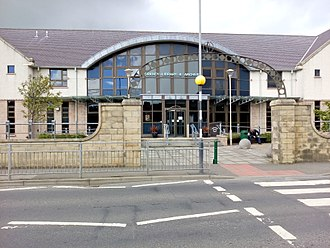
There is a Royal National Lifeboat Institution lifeboat station. One of the major annual events in the town is the Ba Game, held each Christmas
VIII. Other information
Kirkwall Grammar School has been established since circa 1200. The current school building was opened in 2014. The Orkney College main campus is situated in Kirkwall, in a purpose-built building that opened in 2000. Kirkwall has two primary schools, Papdale Primary School which opened in 1955 and Glaitness Primary School which opened in 1979. Robert Gordon University (RGU) in Aberdeen started a research project in 2018 into the history of Orkney Tweed as part of a wider Orkney Project which is using the archives in Kirkwall.
The 'Kirk' of Kirkwall was not the Cathedral (which was originally at Birsay), but the 11th-century church of Saint Olaf of Norway. One late medieval doorway survives from this church, and an aumbry from the original church survives within the late 19th-century structure of the present-day Saint Olaf's Church (Episcopal) in the town's Dundas Crescent. At the heart of the town stands St. Magnus Cathedral, which was founded in memory of Saint Magnus Erlendsson, Earl of Orkney 1108–1117 by Earl (later Saint) Rögnvald Kali. Next to the Cathedral are the ruins of the former Bishop's Palace and Earl's Palace.
IX. Contact information
Mayor/Officer: Steven Heddle
Tel: 01856877119 or 07703795806
Mail: steven.heddle@orkney.gov.uk
Reference Website:
https://www.orkney.gov.uk/Council/Councillors/Steven-Heddle.htm
